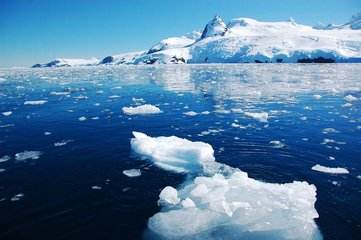(单词翻译:单击)
听力文本
Study: Bering Sea's Ice at Lowest Levels in Thousands of Years
Scientists are reporting that ice cover in the Bering Sea decreased during the winters of 2018 and 2019 to levels not seen in thousands of years. Reuters news agency says the new report adds to concerns about the effect of climate change in the Arctic.
The Bering Sea is in the northern Pacific Ocean, between Russia and the American state of Alaska.
The scientists said satellite images and records provide a clear picture of how the sea ice has changed over the past 40 years. Before that, the only ice records available were from those found in ship records and other observations.
So, scientists turned to peat land on Saint Matthew Island, off the coast of Alaska. Peat is plant tissue that breaks down in wet conditions. It can hold organic substances from plants that lived thousands of years ago.
The researchers studied different forms of oxygen molecules trapped in the peat land. With this information, they were able to estimate atmospheric and ocean conditions that would have affected rainfall and sea ice over a period of 5,500 years.
The researchers reported their findings in Science Advances, a publication of the American Association for the Advancement of Science.
St. Matthew "island in itself has acted as its own weather station," said Matthew Wooller, one of the researchers. He likened the levels of soil in the peat to a "book going back in time."
Wooler is director of the Alaska Stable Isotope Facility at the University of Alaska Fairbanks.

Many studies have shown that the Arctic has warmed in recent years. Sea ice levels in the area around the North Pole have decreased. This year, the summertime Arctic sea ice reached its lowest level for the month of July in 40 years of record keeping.
Sea ice builds up again each year during the winter. But the new study suggests that, in the Bering Sea, sea ice may also be decreasing during cold weather.
The loss of sea ice is already hurting Arctic wildlife, such as walruses, polar bears, and seals. The loss of sea ice also affects indigenous communities that depend on hunting for food and clothing.
Shrinking sea ice intensifies warming in the Arctic. That is because areas of dark water take the place of the sea ice. The dark water absorbs, or takes in, solar radiation instead of reflecting it back into the atmosphere.
"If we lose the sea ice you are completely changing the temperatures of the Arctic," noted Julienne Stroeve, who was not involved in the study. She is a climatologist with the National Snow and Ice Data Center at the University of Boulder Colorado.
The study suggests that changes in the flow of ocean waters and atmospheric conditions linked to climate change have had a big effect. So says Miriam Jones, the lead writer of the study. She is a geologist with the U.S. Geological Survey.
"There's a lot more going on than simply warming temperatures," Jones said. "We're seeing a shift in circulation patterns both in the ocean and the atmosphere," she added.
In addition, the study suggests that changes in sea ice take place at least 20 or more years after changes in carbon dioxide and other heat-trapping gases.
Stroeve suggested that the study could have been strengthened with more comparisons to information gathered by ships and whaling expeditions dating back to the 1800s.
I'm Mario Ritter Jr.
重点解析
重点讲解:
1. break down (使)(物质)分解;
Sugar and starch are broken down in the stomach.
糖和淀粉在胃里被分解。
2. liken to 把…比作;把…比拟为;
She likens marriage to slavery.
她把婚姻比作奴役。
3. take the place of 代替;取代;
Optimism was gradually taking the place of pessimism.
乐观情绪逐渐取代了悲观主义。
4. take in (人、动物或植物)摄入,吸收;
They will certainly need to take in plenty of liquid.
它们当然需要吸收大量液体。
参考译文
研究表明白令海结冰程度达到数千年来最低水平
科学家报告称,2018年和2019年冬季,白令海的冰层覆盖率降至数千年来从未有过的水平。路透社报道称,这份新报告增加了人们对北极气候变化影响的担忧。
白令海位于北太平洋,处于俄罗斯和美国阿拉斯加州之间。
科学家表示,卫星图像和记录提供了过去40年白令海冰层变化的清晰图像。在那之前,唯一可用的冰层记录来自航海记录和其他观测中的发现。
因此,科学家的注意力开始转向阿拉斯加海岸圣马修岛的泥炭田。泥炭是在潮湿环境中分解的植物组织。其可以保存几千年前的植物有机物质。
研究人员研究了被困在泥炭田的不同形式的氧气分子。有了这一信息,他们就能估计出5500年内影响降雨和海冰覆盖的大气和海洋条件。
研究人员在美国科学促进会刊物《科学进展》上报告了他们的研究结果。
其中一名研究员马修·伍勒表示,圣马修岛“本身就是自已的气象站”。他将泥炭田的土壤水平比作一本“时光倒流的书”。
伍德是阿拉斯加费尔班克斯大学阿拉斯加稳定同位素研究所的主任。
多项研究表明,北极近年来不断变暖。北极地区的海冰水平不断下降。今年,北极夏季海冰面积达到40年来7月的最低水平。
每年冬季,海冰会再次堆积起来。但这项新研究表明,白令海的海冰面积在寒冷天气下可能仍在减少。
海冰的消失已经对海象、北极熊和海豹等北极野生动物造成了损害。海冰消失还会对依靠狩猎获得食物和衣物的土著社区产生影响。
海冰收缩加剧了北极地区的变暖趋势。这是因为黑水区域取代了海冰。黑水区吸收太阳辐射,而不是将其反射回大气。
朱莉安妮·斯特罗伊夫表示,“海冰损失意味着北极的温度完全改变。”她并未参与这项研究。她是科罗拉多大学波尔得分校国家冰雪数据中心的气候学家。
研究表明,与气候变化有关的海水流量和大气条件的变化产生了重大影响。这项研究的首席作者米丽亚姆·琼斯如是说。她是美国地质调查局的地质学家。
琼斯说,“不仅仅是气温升高,还有许多变化正在发生。我们看到海洋和大气的环流模式正在发生变化。”
此外,这项研究表明,海冰的变化比二氧化碳和其他吸热气体的变化滞后至少20年或更长时间。
斯特罗伊夫表示,研究结果本可以通过与19世纪的船只和捕鲸探险队收集到的信息进行更多比较来巩固。
小马里奥·里特尔报道。
译文为可可英语翻译,未经授权请勿转载!


